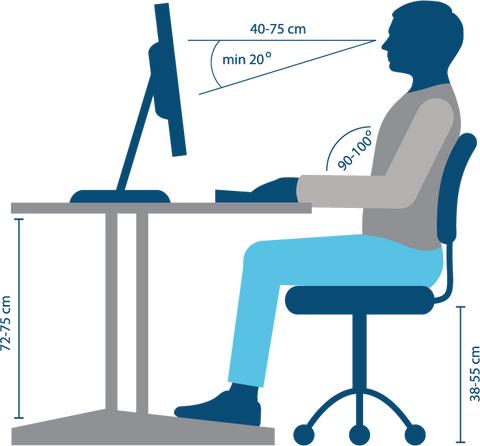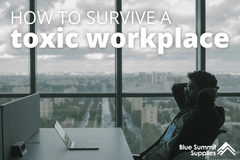Computers have long been one of an office’s most important tools, and there’s no reason to believe that’s going to change any time soon. This has unfortunately led to the development of wrist problems from typing in a growing number of people who have to use a keyboard for many hours every day. Wrist pain when typing may begin as mild discomfort, but it can easily become much more serious if ignored, leading to conditions like Carpal Tunnel Syndrome (CTS) and Repetitive Strain Injury (RSI). If left untreated, wrist pain can become so severe that surgery is required.
Learn more about wrist pain from computer work, including why it happens, how to manage it, and what employers can do to prevent wrist pain at work.

Wrist Pain When Typing
Wrist pain may initially feel like numbness, tingling, stiffness, or general weakness. At first, you might think nothing of it, as it’s hard to imagine that sitting down at your desk and typing in your home, school, or office could be considered even remotely dangerous. Usually, the greatest danger you face under those circumstances is hitting ‘Reply All’.
That said, if you type for long hours every day, it will strain the muscles, nerves, and tendons in your hands, fingers, arms, and wrists. The same is true of any repetitive action. If you spend all day completing a similar task, eventually, you will feel the strain of it.
If the wrist pain you feel when typing continues, it could be pointing to the development of something more serious with very real consequences. It’s important to remember that pain is your body’s way of telling you something is wrong. If your wrists hurt when you type, it’s time to take it seriously.
Pain in Hands From Typing Is Serious

Sore Wrist From Typing
If typing is an important part of your job, as it is for many people who work in an office, wrist pain can go from slightly inconvenient to impossibly annoying fast. Taking meeting notes or sending an email suddenly become Herculean feats of endurance.
Wrist pain can completely derail your efficiency and productivity, leaving you challenged by regular, day-to-day tasks. After a while, you may find you begin to avoid tasks that include a lot of typing, and you could fall behind in your work duties.
Even if the pain is manageable at first, it’s more than likely to become severe over time. Beginning to mitigate it before it progresses is a crucial step in preventing further damage.
A Wrist Injury From Typing: Carpal Tunnel and Long-Term Effects
If you’ve been ignoring the pain and discomfort in your wrists for a while, you may suddenly notice a sharp, intense pain in your wrist that shoots the whole way up your arm. This is a sign that your wrist situation has just gone from bad to worse. It’s likely that the pain will be followed by stiffness and cramping, pins and needles, or a throbbing, pervasive ache. This feeling may only occur during or immediately after a typing session, or it could follow you around for the entire day and into the night.
Carpal tunnel syndrome (CTS) is one of the most common causes of wrist pain. It’s caused by the compression of nerves in the hand and wrist. The carpal tunnel is a thin, rigid passageway of bones and ligaments at the base of your hand. It houses the median nerve, which runs from the forearm to the palm of the hand, and tendons that together help control the feeling and movement of your hand.
The thickening of irritated tendons or other swelling narrows the carpal tunnel and compresses the median nerve, causing pain, numbness, or weakness in the wrist, hand, or forearm, making it difficult to type or grasp objects.
If the median nerve is damaged, it can take quite a long time to properly heal. If symptoms go untreated, it can result in permanent nerve damage or the need for surgery. This is why it’s so important to seek treatment and preventative measures early on.
What To Do if Your Wrist Hurts From Typing

Don’t Ignore the Problem
Pain is your body telling you (or SCREAMING at you) to stop doing what you’re doing. Ignore pain at your own peril. As soon as you notice wrist pain when typing, consult your healthcare professional, make adjustments, and monitor yourself for changes. The faster you take action, the more likely it is your wrists will heal. You can reduce inflammation with an anti-inflammatory drug, wear a wrist brace, and do your best to avoid long typing sessions.
Stretch Your Wrists Before and After Typing
Stretching your wrists throughout the day, especially right before you’re about to type,
can relieve wrist pain and prevent wrist injuries from occurring. Simple stretching exercises only take a couple of minutes. Consider stretching your wrists when you take a break from work instead of jumping on your phone right away. You can also sneak in a wrist exercise while you wait for coffee to brew, stand in line, or while your lunch is heating up.

Take Breaks and Use Them Wisely
No one is too busy to take a break; in fact, taking a break is even more important the busier you are. Your brain needs a moment to recharge in order to stay sharp and maintain productivity. Even if your job doesn’t require strenuous physical work, your body still needs a break too.
Sitting at your desk all day, answering the phone repeatedly, or typing for long stretches of time puts strain on your body, especially if you don’t take a proper break. If you struggle to find the time for breaks, set a timer to remind you. The pomodoro method of working in short bursts forces a five minute break for every 25 minutes of working.
When you take your breaks, use them wisely. Don’t waste time scrolling on your phone or browsing on your computer. Get up and move around, stretch, and practice mindfulness. This is a good time to complete wrist exercises, and it will do your mind some good to focus on something that isn’t whatever's on your computer screen.

Mix Up Your Work Tasks
If you find your wrists get sore after long stretches of typing, do your best to mix up your tasks throughout the day. If your job allows it, instead of doing all of your typing tasks at once, spread them out over the course of your day. Break up your typing with stretching breaks and other productive tasks, such as making phone calls, using the printer, speaking with a colleague, or tidying your workspace.
Set Up a Proper Workstation
Often wrist pain is caused by a poorly set up workstation. Placing your hands at an odd angle when typing can put unnecessary strain on your wrists that, after a while, will develop into pain and discomfort. Your keyboard should be set up to allow your elbows to bend at a 90 degree angle . A keyboard tray can help create the best angle for your wrists, or you can invest in wrist resting pads that cushion your wrists when typing or using a mouse.
Ask your employer what options are available to establish a safe and comfortable workstation. They may be able to help you acquire the products you need, or they may already have them available in the office.
Watch Your Posture
Posture plays a big role in the comfort or discomfort you feel when working at a desk. Working with poor posture can contribute to wrist pain as well as a number of other strains on your body, including back and neck pain, digestive issues, and poor circulation.
Practice proper form when working at a desk. Keep your feet flat on the ground, relax your shoulders, keep your elbows at 90 degrees when typing, and keep your spine straight. This may take practice at first, but in the long run, it will reduce your risk of developing wrist pain and other office-related strains.


A good office chair can help you maintain proper form when typing. Learn more about proper posture, how to fight back pain, and what office chairs are best.
How Employers Can Prevent Wrist Pain at Work

Invest in Ergonomic Workstations
An ergonomic workstation means that your workspace is set up in such a way that everything you need on your desk is well within reach. They prevent injury by promoting good posture and reducing any possible strain on the body.
Investing in ergonomic workstations and furniture for your employees is beneficial for several reasons. They improve productivity by reducing strain and promoting proper posture; an employee uses less energy when sitting or standing properly, which means they’ll be able to work more efficiently, and they won’t be distracted by an uncomfortable chair. They also reduce the chances that an employee will suffer a work-related injury and be forced to take a leave of absence.
Plus, there’s the aesthetic appeal; office visitors will like what they see, and it may attract top talent.
Provide Learning Opportunities
Educate your team on the risks of wrist pain as well as the correct way to sit when typing.
Team building opportunities that educate employees provide an opportunity for your team to learn something new together. Give your team all of the tools they need to make smart and healthy decisions about how they work.
Encourage Breaks
Your employees need to know they can take breaks. Ensure your entire team knows this and that breaks are supported. They’ll be more productive and focused in the long run if they are taking regular breaks. Encourage healthy breaks away from a computer screen or phone. You can suggest your team uses their breaks to eat a healthy snack, get outside, meditate, or stretch.

Reduce Typing Tasks
If you have an employee that suffers from wrist pain, do what you can to accommodate their needs. Ensure they are taking regular breaks and reduce their typing tasks. Could another employee split up the typing work, or maybe the typing task isn’t needed at all? Audio transcription software has come a long way in recent years, reducing the need for typing altogether.
More from Blue Summit Supplies
💡 How to Manage Office Scents For Employees Sensitive to Smell
💡 How to Survive a Toxic Workplace
We’re passionate about office productivity and wellness. Follow our office supplies blog for the latest trends, office strategies, product comparisons, and more.
If you have any questions or want to talk to someone about office supplies, send us an email or connect with us on Twitter, Facebook, or Instagram.
 For more informative articles about office supplies, subscribe to our email newsletter!
For more informative articles about office supplies, subscribe to our email newsletter!
Never fear, you won't begin receiving daily sales emails that belong in a spam folder. Instead, we promise a fun weekly roundup of our latest blog posts and great finds from across the web. And if you lose interest, it's always easy to unsubscribe with a single click.









